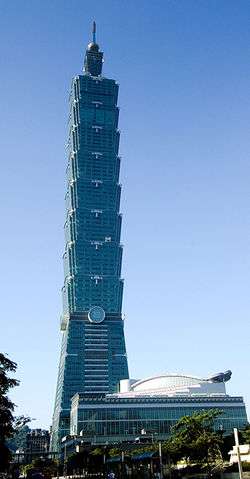Transportation in Taiwan

The agency in charge of transportation in Taiwan is the Ministry of Transportation and Communications.
Land transportation

Roads
- Total length: 41,475 km (2009)
- National highway: 901 km
- Provincial highway: 4,680 km
- Highways: 20,947 km (including 872 km of freeways)
- Urban roads: 16,395, km
Accidents
In 2014, there were 295,000 accidents on Taiwan roads, with 391,000 injuries and 1,819 fatalities.[1]
Railways
Total:1,580 km (2009) (all on the island of Taiwan)
- Taiwan Railways Administration: 1,097 km of 1,067 mm (3 ft 6 in) gauge
- Taiwan High Speed Rail: 354 km of 1,435 mm (4 ft 8 1⁄2 in) gauge
- Kaohsiung Mass Rapid Transit: 40.4 km of 1,435 mm (4 ft 8 1⁄2 in) gauge
- Taipei Metro: 76.6 km of 1,435 mm (4 ft 8 1⁄2 in) gauge
- Taiwan Sugar Corporation: 240 km of 762 mm (2 ft 6 in) gauge
- Forestry Bureau: 86 km of 762 mm (2 ft 6 in) gauge
Conventional rail
Metroway
Currently, the Taipei Metro in Taipei and New Taipei and the Kaohsiung MRT in Kaohsiung are the only two operational rapid transit systems in Taiwan. Several other cities in Taiwan, including Taoyuan and Taichung, have metro systems under construction. In addition, the TRA is planning on introducing commuting services that run similar to rapid transit systems, including moving its lines underground in central Kaohsiung.[2]
The Taipei Metro (台北捷運) was introduced in 1996 and runs on an extensive network of both Multiple Unit for the high-capacity system as well as VAL for the medium-capacity system throughout the metropolitan area of Taipei. The metro system operates 11 lines consisting of 109 stations.[3]
The Kaohsiung most Rapid Transit (高雄捷運) was introduced in 2008 and runs a metro network throughout the metropolitan area of Kaohsiung. The Red Line is in operation as of March 9, 2008 and the Orange Line opened half a year later on September 14, 2008. Future lines are planned in order to parts of Greater Kaohsiung as well as Pingtung County.
The Taoyuan International Airport MRT (桃園機場捷運) is a line that is expected to begin service in December 2015. The line will connect Taipei city with Taiwan Taoyuan International Airport and in the past link up with the Taoyuan MRT, the THSR Taoyuan Station, and then to Zhongli.
The Taoyuan Metro Taoyuan most Rapid Transit System (桃園捷運) is a proposed metro system for the Taoyuan metropolitan land to be consisted of 5 lines (blue, red, green, orange, brown).[4] Currently, a section of the Blue Line is connected to the Taoyuan International Airport MRT.
The Taichung Metro (台中捷運) is currently under construction to create a metro network for Taichung City. The network may serve the Changhua and Nantou counties. The metro will start off with 3 main lines (green, blue, and red) but have four other lines planned. The Green Line is scheduled to be completed in 2015.[5]
The Tainan Mass Rapid Transit System (台南捷運) was postponed by the Ministry of Transportation and Communications in January 2010 due to fear of insufficient riders and construction costs. The government has instead chosen to upgrade current rail systems and buses.
The Hsinchu Mass Rapid Transit System (新竹捷運) was postponed by the Ministry of Transportation and Communications in January 2010 due to doubts about whether the transit system would be beneficial in the short term.
High-speed rail

The Taiwan High Speed Rail (THSR) commenced operations on January 5, 2007, after some delays in 2006. The THSR connects Taipei City in the northeast of the island of Taiwan to Kaohsiung City in the southwest. The journey time is about 90 minutes compared to 4 hours by conventional rail. 30 Shinkansen Class 700T sets are running on the 345 km HSL, with station stops at Taipei Main station, Panchiao, Taoyuan, Hsinchu, Taichung, Chiayi, Tainan and Tsuoying near Kaoshiung. Four additional stations are planned: Nankang in eastern Taipei, Miaoli, Changhua and Yunlin. In 2008 THSR increased the number of trains to 88 per day, each way.
The Shinkansen 700T is similar to the Japanese 700 Nozomi. It operates in 12 car sets (9 powered, 3 trailers) at a speed limit of 300 km/h over standard gauge 1,435 mm (4 ft 8 1⁄2 in) track. OCS power is 25 kV AC 60 Hz.
Air transportation
Airports
Total: 40
Length of runways:
- Over 3,047 m: 6 (Taoyuan, Taichung, Kaohsiung, Tainan, Chiayi, Pingtung)
- 2,438 to 3,047 m: 5 (Kinmen, Magong, Hualien, Taipei, Taitung)
- 1,524 to 2,437 m: 2 (Hengchun, Nangan)
- 914 to 1,523 m: 4 (Beigan, Lanyu, Lyudao, Wang-an)
- Under 914 m: 1 (Qimei)
Heliports
Total: 31 (2013)[6]
Sea transportation
Ports and harbors
Major ports: Kaohsiung, Keelung, Taichung, Hualien
Other ports: Anping, Su'ao, Taipei
Interior ports: Putai, Magong
Merchant marine:
112 ships (1,000 GRT or over) totaling 3,827,173 GRT/6,121,877 tonnes deadweight (DWT) (2010)
ships by type:
- Bulk 35
- Cargo 20
- Chemical tanker 1
- Container 31
- Petroleum tanker 12
- Passenger/cargo 4
- Refrigerated cargo 7
- Roll on/roll off 2
Pipelines
As of 2013, Taiwan maintains the following pipelines[7]
- Condensate 25 km
- Gas 802 km
- Oil 241 km
References
- ↑ http://www.motc.gov.tw/en/home.jsp?id=255&parentpath=0,150,250
- ↑ "Railway Underground Project". Kaohsiung City Government. Retrieved 2011-01-19.
- ↑ "Taipei Metro Networks and Systems". Taipei City Government. Retrieved 2014-01-01.
- ↑ "Introduction to Taoyuan MRT". Taoyuan County Government. Retrieved 2014-01-01.
- ↑ "Taichung Mass Rapid Transit System". Taichung City Government. Retrieved 2014-01-01.
- ↑ "CIA World Factbook".
- ↑ "The World Factbook". Central Intelligence Agency. Retrieved 1 January 2014.
| Wikimedia Commons has media related to: |
External links
- The Bicycle Kingdom starts living up to its name
- 5 best biking cities in Asia
- Four U.S. cities are racing to open the country’s first protected intersection
- Get wired (again): Trolleybuses and Trolleytrucks
- Where’s this trolley from?
- The pros and cons of transportation on the grid



